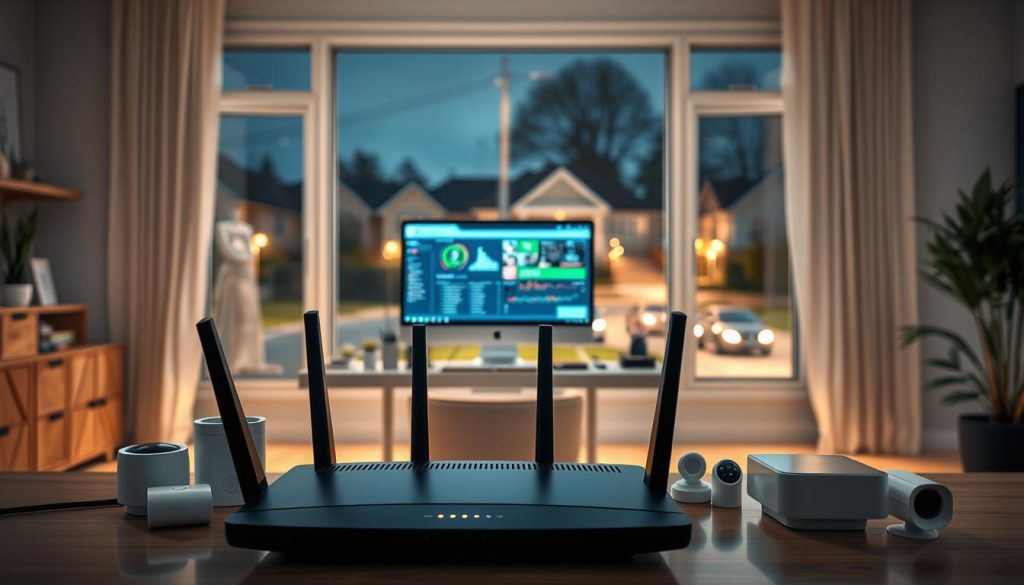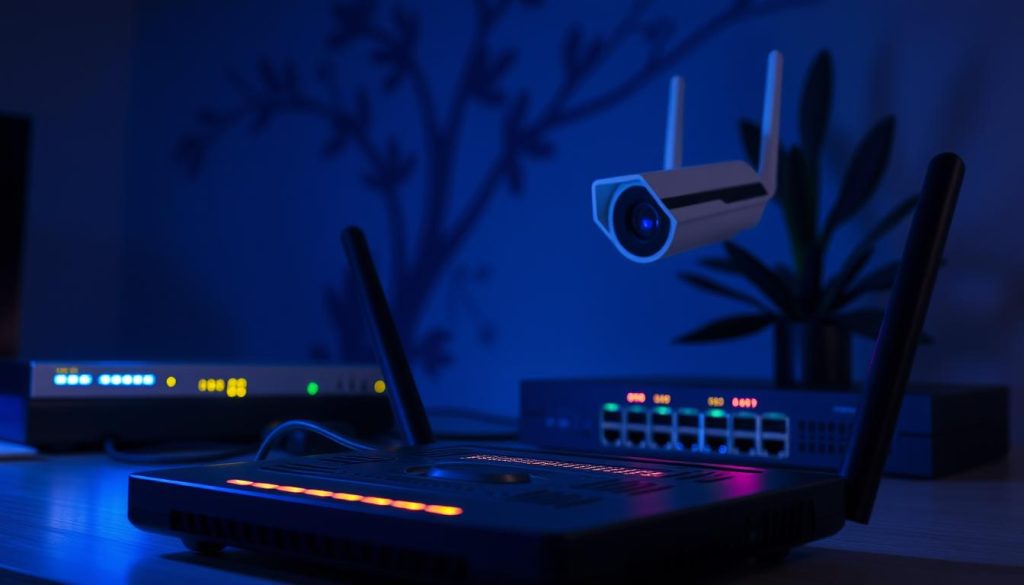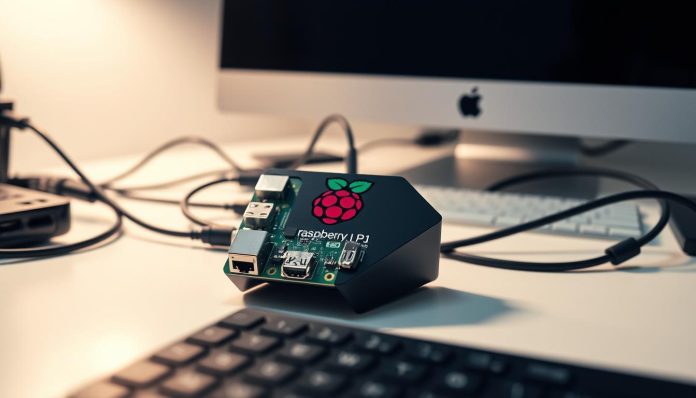Keeping your home network security safe is key in today’s world. With more smart devices around, protecting your network is a must. Building a firewall with Raspberry Pi or similar hardware is a smart move.
This method gives you a strong network security option. It’s also cheaper and can be tailored to fit your needs. By doing this, you can keep your personal info and devices safe from hackers.
Key Takeaways
- Understand the importance of home network security in the digital age.
- Learn how to build a firewall using Raspberry Pi or similar hardware.
- Enhance your DIY home security with a customizable firewall solution.
- Improve your network security with a cost-effective approach.
- Take control of your personal data and device security.
Introduction to Firewalls
Learning about firewalls can greatly improve your network’s security. A firewall is like a shield between your network and the internet. It controls what data can go in and out, based on your security rules. This important step helps keep your network safe from unwanted access and harm.
A firewall is key to a strong home security system, especially with smart home tech. It watches over your network traffic. This lets you decide what data can pass through, keeping your devices and data safe from threats.
One big plus of having a firewall is its role as an intrusion detection system. It checks incoming and outgoing traffic. If it finds something suspicious, it blocks it. This is crucial for keeping your smart home tech safe.
Building your own firewall with hardware like Raspberry Pi can be a smart move. It’s a way to boost your network security without spending a lot. With the right setup, your firewall can fit your home network’s needs, guarding against cyber threats.
- Network traffic control
- Intrusion detection and prevention
- Customizable security settings
By setting up a firewall, you can make your home network much safer. This ensures a secure online space for all your connected devices.
Understanding Raspberry Pi
Raspberry Pi is a great choice for making your own home firewall. It’s affordable and works well. Raspberry Pi is a series of small computers that are perfect for DIY projects.
Raspberry Pi has features that are great for a firewall. It has:
- A strong processor for handling network traffic
- Multiple USB ports for adding devices
- Ethernet or Wi-Fi for connecting to the internet
- GPIO pins for growing your setup
When picking a Raspberry Pi for your firewall, think about a few things:
- Processing Power: The latest models, like Raspberry Pi 4, are faster.
- Memory: Make sure it has enough RAM (at least 2GB) for smooth running.
- Connectivity: If you want wireless, choose a model with Wi-Fi.
You might also need extra hardware for your firewall. This could be:
| Hardware Component | Purpose |
|---|---|
| MicroSD Card | For storing your operating system and firewall software |
| Power Supply | A good power adapter for your Raspberry Pi |
| Ethernet Cable | To connect your Raspberry Pi to your network |
Knowing what Raspberry Pi can do helps you plan your DIY home security. It’s a versatile tool for improving your home automation or setting up a strong firewall.
Software Options for Your Firewall
Choosing the right software for your firewall is key to better network security. There are many options, each with its own features and benefits. Knowing what each offers can help you decide.
OpenWrt is a popular choice. It’s an open-source operating system for embedded devices. It’s great for advanced users who want to customize their firewall settings.
Pi-hole is another favorite. It’s a network-wide ad blocker that also acts as a firewall. It’s easy to use and blocks ads at the network level. This improves both security and your browsing experience.
Key Features to Consider
- Customization: Choose software that lets you customize settings to fit your security needs.
- Ease of Use: Pick software with an easy-to-use interface that makes setup and monitoring simple.
- Community Support: Software with active community support is great for help and updates.
When picking firewall software, think about your level of expertise and your network’s needs. For complex networks, OpenWrt’s advanced features might be better. For simpler setups, Pi-hole could be the way to go.
The best firewall software balances functionality with ease of use. It should keep your network safe without slowing it down.
Network Security Basics
Your home network’s security depends on the steps you take to protect it. Knowing the basics of network security is key to keeping your digital life safe.
Network security means keeping your network safe from unauthorized access and threats. This includes fighting off malware, viruses, and other cyber dangers.
Common Threats to Home Networks
- Malware and viruses that can harm your devices and data.
- Unauthorized access to your network, which could lead to data theft or harm.
- Denial of Service (DoS) attacks that can make your network unusable.
A strong firewall is vital for network security. It acts as a shield between your network and the internet. It blocks harmful traffic and stops unauthorized access.

An intrusion detection system (IDS) boosts your network security. It watches network traffic for signs of unauthorized access or malicious activity.
By learning these network security basics and taking action, you can greatly improve your home network’s security.
Preparing Your Hardware
Before you install the firewall software, make sure to prepare your Raspberry Pi hardware correctly. You need to gather the right parts and set up the device. This will get it ready for your DIY home security project.
You’ll need a few key items. These include a Raspberry Pi board, a power supply, an SD card for storage, and an Ethernet cable or Wi-Fi adapter for network access. Make sure your Raspberry Pi model works with the latest software updates. This will help it perform well in your home automation setup.
With all the necessary hardware, follow these steps to set up your Raspberry Pi:
- Insert the SD card into the Raspberry Pi.
- Connect the power supply to the Raspberry Pi.
- Use an Ethernet cable to connect the Raspberry Pi to your router, or configure the Wi-Fi adapter.
- Power on the Raspberry Pi and ensure it’s functioning correctly.
After setting up your Raspberry Pi, you’ll need to configure it to connect to your network. You’ll need to assign a static IP address. This ensures consistent connectivity and makes it easier to access your home automation firewall.
By carefully preparing your hardware, you’re on your way to creating a strong DIY home security system. It will protect your network and automate your home’s security features.
Installing Firewall Software
Installing firewall software on your Raspberry Pi is key to securing your home network. You’ll need to download, install, and set up the software to protect your network.
First, pick a firewall software. pfSense and OpenWRT are good choices. They work well with Raspberry Pi and offer strong security.

- Download the software image from the official website.
- Use Etcher to put the image on your microSD card.
- Put the microSD card in your Raspberry Pi and start it up.
- Follow the on-screen steps to finish the installation.
After installing, you’ll need to set it up. This means setting up network interfaces, firewall rules, and extra features like VPN or content filtering.
| Feature | pfSense | OpenWRT |
|---|---|---|
| Firewall Rules | Advanced rule configuration | Flexible rule setup |
| VPN Support | Built-in VPN server | Supports multiple VPN protocols |
| Content Filtering | Integrated content filtering | Third-party package available |
Fixing common installation problems is important. Some issues include:
- Make sure your microSD card is flashed right and seen by your Raspberry Pi.
- Double-check that your Raspberry Pi is hooked up to the network.
- Look at the software’s manual for specific setup and config tips.
By following these steps and tips, you can set up firewall software on your Raspberry Pi. This will boost your home security system and network security.
Configuring Firewall Rules
Firewall rules are key to your network’s safety. They decide what traffic gets through or is stopped. It’s vital to set them up right to keep your home network safe from unwanted access and threats.
To begin, you need to know the basics. A firewall rule has conditions and actions. If traffic meets the conditions, the action is taken, like letting it through or blocking it. Knowing how to make these rules is crucial for a secure home network security setup.
First, decide what traffic you want to let in or out. For example, if you’re hosting a web server, you’ll need to open ports 80 and 443 for HTTP and HTTPS. You might also block traffic from known bad IP addresses to stop intrusions. Adding an intrusion detection system can also help by spotting and warning you about threats.
When setting up your rules, think about the order they’re applied. Firewalls follow rules from top to bottom, so specific rules should come first. For instance, you might have a rule for all outgoing traffic, but block a certain app from the internet. The app block rule should come before the general allow rule.
Testing your firewall setup is crucial. Use network scanning tools to check if your firewall is working right. It’s also key to regularly check and update your rules as new threats come up and your network needs change.
By carefully setting up your firewall rules and staying up-to-date on security threats, you can greatly improve your home network security. Remember, a well-set-up firewall is a strong defense for your network and data.
Monitoring Network Activity
Keeping an eye on your network is key to keeping your smart home safe. It helps spot security threats early and act fast to stop them.
Using the right tools is important for network monitoring. Tools like PRTG Network Monitor and Nagios can track traffic, find odd patterns, and warn you of problems.

Looking at your network’s traffic is crucial. It helps find unusual data transfers, strange devices, or other odd behavior. This way, you can spot and fix security issues.
Key Aspects of Network Activity Monitoring
- Detecting and responding to security threats in real-time
- Analyzing network traffic patterns for anomalies
- Maintaining detailed logs of network activity for security audits
- Ensuring compliance with network security policies
Keeping detailed logs of your network is also vital. These logs track changes, spot security breaches, and help in audits. Make sure to keep these logs safe from tampering.
| Tool | Features | Use Case |
|---|---|---|
| PRTG Network Monitor | Real-time monitoring, traffic analysis, alert system | Ideal for comprehensive network monitoring |
| Nagios | Monitoring of network services, alert system, log analysis | Suitable for detecting and responding to security threats |
| Wireshark | Deep packet inspection, protocol analysis | Useful for detailed traffic analysis and debugging |
With a strong network monitoring plan, you can greatly improve your smart home’s security. This helps keep your network safe from threats.
Troubleshooting Common Issues
Setting up your DIY home security firewall can sometimes lead to problems. Issues like connectivity and software setup are common. But, with the right steps, you can fix these problems.
Common Issues and Solutions
- Make sure your Raspberry Pi is well connected to your network. Also, check that the power supply is steady.
- Double-check that your firewall software is set up right. It should let in the right kinds of traffic.
- Look for any IP address conflicts in your network.
If you’re still having trouble, there are many online resources to help. Tech forums and guides are full of tips. For example, Raspberry Pi and network security forums have lots of shared solutions.
By tackling these common problems, you can make sure your DIY home security firewall works well. It will help protect your network effectively.
Advanced Features to Consider
To boost your firewall, think about adding advanced features. These can improve security and make things more automated. For example, VPN support lets you make secure, encrypted connections to your home network from anywhere.
Adding an Intrusion Detection System (IDS) and Intrusion Prevention System (IPS) can also help. These systems watch for unauthorized access or malicious activity in your network. This way, you can quickly act on potential threats.

Consider using custom scripts for automation too. They can automate tasks and responses to security events. This makes your network more secure and saves you time.
Make sure these advanced features are set up right and watched closely. Check your firewall often to see how it’s doing. This helps keep your home network safe from new threats.
Maintaining Your Firewall
Keeping your firewall up to date is key to your network’s security. It’s important to regularly update and check your firewall. This helps protect against new threats and keeps your network safe.
Regular Updates and Checks are crucial for your firewall’s success. Make sure your firewall software is always current. Also, review your firewall rules and look for any weaknesses. Keep an eye on system logs to catch and handle security issues.
- Regularly review and update firewall rules to ensure they align with your current network security needs.
- Use an intrusion detection system (IDS) to monitor network traffic for signs of unauthorized access.
- Schedule routine checks to identify and address potential vulnerabilities.
| Maintenance Task | Frequency | Importance |
|---|---|---|
| Update Firewall Software | Monthly | High |
| Review Firewall Rules | Quarterly | High |
| Check for Vulnerabilities | Bi-Annually | Medium |
By sticking to these steps and keeping your firewall in good shape, you’ll greatly improve your network security. This will help protect against many threats.
Conclusion
You now know how to make your own firewall with Raspberry Pi or similar devices. This boosts your home security and keeps your network safe from threats.
By following the steps in this article, you can build a strong DIY home security system. This includes setting up a home intrusion detection system. It will alert you to any suspicious activity.
Start securing your home network today. Look for more resources to learn about home security and network protection. Begin creating a safer digital space for yourself.

